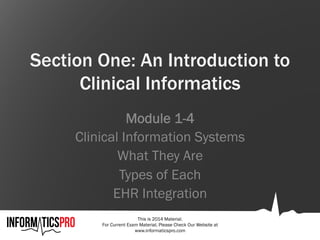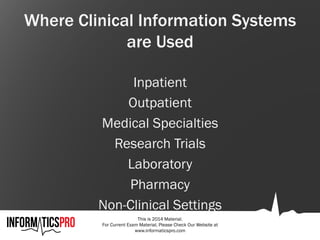1-4 An Introduction to Clinical Informatics: Clinical Information Systems
- 1. This is 2014 Material. For Current Exam Material, Please Check Our Website at www.informaticspro.com Section One: An Introduction to Clinical Informatics Module 1-4 Clinical Information Systems What They Are Types of Each EHR Integration
- 2. This is 2014 Material. For Current Exam Material, Please Check Our Website at www.informaticspro.com What is a Clinical Information System? Clinical Information Systems (or Healthcare Information Systems) are systems that capture, store, manage, transmit, and/or recall organizational or personal health information
- 3. This is 2014 Material. For Current Exam Material, Please Check Our Website at www.informaticspro.com Uses of Clinical Information Systems •  Clinical Functions •  Patient Management •  Practice Management •  Health System Management •  Public Health Management •  Research Management •  Payer Management
- 4. This is 2014 Material. For Current Exam Material, Please Check Our Website at www.informaticspro.com Where Clinical Information Systems are Used Inpatient Outpatient Medical Specialties Research Trials Laboratory Pharmacy Non-Clinical Settings
- 5. This is 2014 Material. For Current Exam Material, Please Check Our Website at www.informaticspro.com Electronic Health Record (EHR) •  A systematic collection of electronic health information about an individual patient or population of patients – Allows practitioners to record and share data
- 6. This is 2014 Material. For Current Exam Material, Please Check Our Website at www.informaticspro.com EHRs •  Benefits: Eliminates paper records, decrease handwriting errors, allows for implementation of error-reducing technology, lays foundation for a longitudinal health record, allows those eligible to receive meaningful use incentives •  Drawbacks: Additional privacy, security, cost, software, and quality of care concerns. Possibility for unintended consequences and changes to workflows, communication, and data entry demands.
- 7. This is 2014 Material. For Current Exam Material, Please Check Our Website at www.informaticspro.com Clinical Decision Support & Clinical Decision Support Systems (CDS/CDSS) •  Clinical Decision Support [Systems] provide clinicians, staff, patients, and other individual with knowledge and person- specific information, intelligently filtered or presented at appropriate times to enhance health and health care – Provides alerts, pop-ups, reminders, condition- specific order sets, diagnostics, patient reports and summaries, and other relevant information
- 8. This is 2014 Material. For Current Exam Material, Please Check Our Website at www.informaticspro.com CDS/CDSS •  Benefits: Reduced clinical errors, increased quality of care, improved efficiency, increased patient and provider satisfaction •  Drawbacks: Alert Fatigue, Ethics and Malpractice
- 9. This is 2014 Material. For Current Exam Material, Please Check Our Website at www.informaticspro.com Computerized Patient Order Entry (CPOE) •  A system that allows physicians and medical practitioners to electronically enter patient treatment instructions – Information may be sent directly to the pharmacy, lab, or radiology departments. CPOE can incorporate patient decision support, patient safety features, billing codes, and more
- 10. This is 2014 Material. For Current Exam Material, Please Check Our Website at www.informaticspro.com CPOE •  Benefits: Decreases time to order completion, reduces prescription errors, improves dosage timing for patients, reduces transcription errors •  Drawbacks: Time-consuming and problematic usability, enforcement of predefined relationships between clinical tasks and between providers
- 11. This is 2014 Material. For Current Exam Material, Please Check Our Website at www.informaticspro.com Imaging / Picture Archiving and Communication System (PACS) •  A system that provides add to and storage of medical image documents in electronic form – Allows X-rays, CT, MRIs, and other images to be reviewed and interpreted by physicians in a timely matter – Uses Digital Imaging and Communications in Medicine (DICOM) standard
- 12. This is 2014 Material. For Current Exam Material, Please Check Our Website at www.informaticspro.com PACS •  Benefits: Replaces traditional film retrieval/ distribution/display, allows for remote access, improves image workflow, integrates with EHRs and other CIS •  Drawbacks: Once “filmless”, difficult to revert to a film environment, utilizes large amounts of bandwidth, requires high-resolution monitors for reading “films”, expensive
- 13. This is 2014 Material. For Current Exam Material, Please Check Our Website at www.informaticspro.com Laboratory Information System (LIS) •  Provides workflow management, data tracking, data exchange, and other features to support laboratory operations – Varying levels of LIS complexity can do everything from simply track samples to provide lab analytics, audit trails, compliance, calibration, maintenance, QA, and reporting
- 14. This is 2014 Material. For Current Exam Material, Please Check Our Website at www.informaticspro.com LIS •  Benefits: Sample management, quality control, sample data storage, instrumentation and application integration, limit checking •  Drawbacks: May need custom workflow interfaces, must use adequate validation
- 15. This is 2014 Material. For Current Exam Material, Please Check Our Website at www.informaticspro.com Inventory Management System •  Manages supply levels and usage throughout a health care system
- 16. This is 2014 Material. For Current Exam Material, Please Check Our Website at www.informaticspro.com LIS •  Benefits: Real-time inventory levels, increase charge capture for supplies, allows for lower inventory levels •  Drawbacks: Must be fully integrated into providers workflow to be useful – un- captured usage of inventory results in inaccurate results
- 17. This is 2014 Material. For Current Exam Material, Please Check Our Website at www.informaticspro.com Personal Health Record •  A health record where the data is managed by the patient, not the healthcare provider – Allows patients to share their information with providers
- 18. This is 2014 Material. For Current Exam Material, Please Check Our Website at www.informaticspro.com Personal Health Record •  Benefits: Improves communication between provider and patient, covers medical history that may otherwise be spread out between EHRs •  Drawbacks: Privacy concerns, patient failure to disclose some health activities/events/ histories, not clinically detailed
- 19. This is 2014 Material. For Current Exam Material, Please Check Our Website at www.informaticspro.com EHR as the Foundation
- 20. This is 2014 Material. For Current Exam Material, Please Check Our Website at www.informaticspro.com Review Questions 1.  The CIS which helps pharmacies electronically receive prescriptions from physicians is a: 1.  LIS 2.  EHR 3.  CPOE 4.  PHR
- 21. This is 2014 Material. For Current Exam Material, Please Check Our Website at www.informaticspro.com Review Questions 1.  The CIS which helps pharmacies electronically receive prescriptions from physicians is a: 1.  LIS 2.  EHR 3.  CPOE 4.  PHR Computerized patient order entry lets physicians send their orders electronically to the pharmacy. CPOE combined with CDSS & EHR can check for drug-allergy and drug-drug reactions and alert users to possible errors.
- 22. This is 2014 Material. For Current Exam Material, Please Check Our Website at www.informaticspro.com Review Questions 1.  A system that provides alert, pop-ups, and reminders based on clinical guidelines and rules is known as a(n): 1.  EHR 2.  CDSS 3.  CPOE 4.  PACS
- 23. This is 2014 Material. For Current Exam Material, Please Check Our Website at www.informaticspro.com Review Questions 1.  A system that provides alert, pop-ups, and reminders based on clinical guidelines and rules is known as a(n): 1.  EHR 2.  CDSS 3.  CPOE 4.  PACS CDSS provide alerts, pop-ups, and reminders, as well as guidelines, order sets, diagnostics, reports, summaries, and other relevant information for physicians to make informed decisions regarding their patient’s health.







![This is 2014 Material.
For Current Exam Material, Please Check Our Website at
www.informaticspro.com
Clinical Decision Support & Clinical
Decision Support Systems
(CDS/CDSS)
•  Clinical Decision Support [Systems] provide
clinicians, staff, patients, and other
individual with knowledge and person-
specific information, intelligently filtered or
presented at appropriate times to enhance
health and health care
– Provides alerts, pop-ups, reminders, condition-
specific order sets, diagnostics, patient reports
and summaries, and other relevant information](https://image.slidesharecdn.com/1-4clinicalinformationsystems-160511233808/85/1-4-An-Introduction-to-Clinical-Informatics-Clinical-Information-Systems-7-320.jpg)















